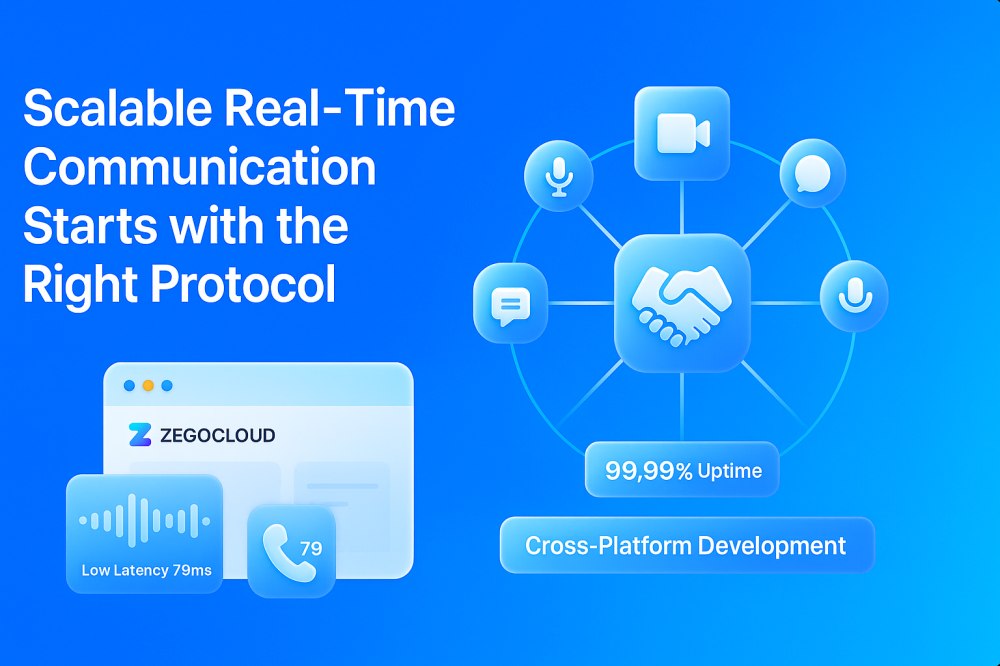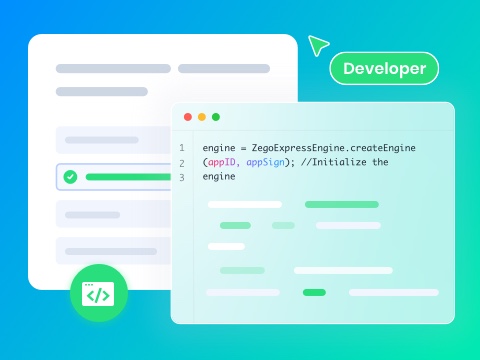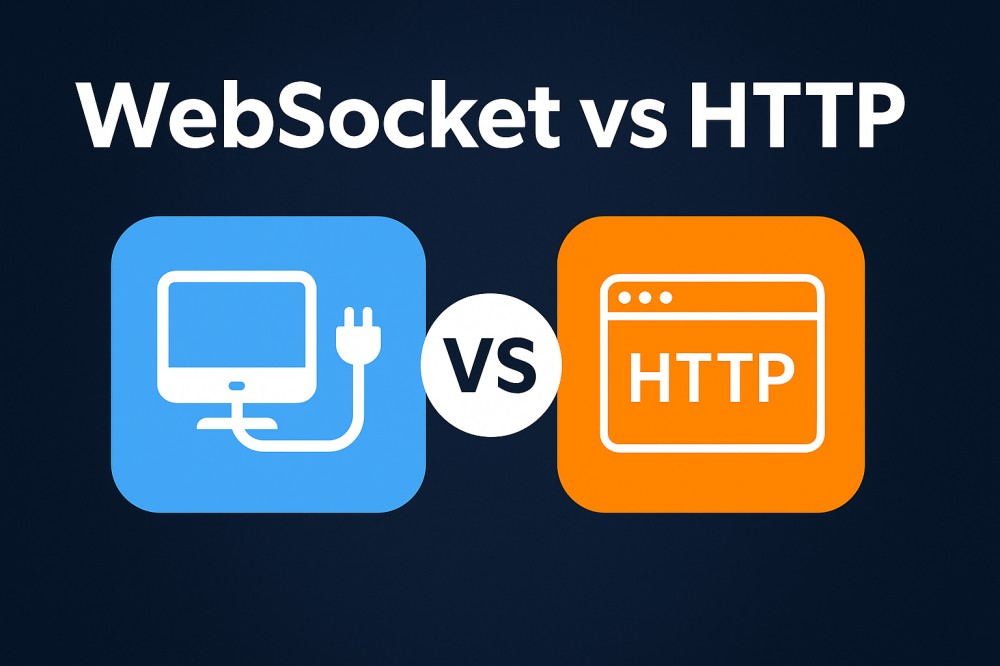In the current era, where instant communication and data exchange are important, selecting the ideal protocol can help enhance your application’s performance. While doing so, the discussion often revolves around powerful competitors, such as WebSocket vs HTTP. To learn about which one is better for your project, this guide will provide you with the key differences between these two things, their strengths, and ideal use cases.
Explanation of HTTP
To understand the significance and functionality of HTTP, we should first learn what it is. Therefore, review this section since it will define the term while highlighting its pros and cons:
What is HTTP?
While debating about HTTP vs WebSocket, the Hypertext Transfer Protocol is a widely used unidirectional request-response protocol. It allows clients and the server to transmit their data over the web. The first version of HTTP was developed by Tim Berners-Lee in 1989, which was based on narrow implications. Basically, HTTP serves as the backbone of data communication on the internet, providing access and display of web pages and web data.
How Does HTTP Work?
The difference between WSS and HTTPS is that HTTPS works as a connection between client and server. Here, the client sends the HTTP request to the server hosting the desired content. Then, each request is handled with a corresponding response, after which the connection gets closed, and on every new request, a new connection is created. Besides, it uses TCP, based on a three-way handshaking method, as a connection-oriented protocol.
Advantages and Disadvantages of HTTP
While discussing WebSocket vs HTTP, we have to examine HTTP in detail. This includes understanding its following weaknesses and strengths to appreciate its role in web communication fully:
Advantages
- HTTP provides fast and efficient identification of IP Addresses, which provides ease for faster connection to web resources. This quick connection to the web improves the overall user experience by elegant access.
- This protocol allows for the seamless download of plugins and extensions, enabling users to customize their browsing experience according to developer needs. Hence, customizing the web according to your preference greatly enhances the functionality of web browsing.
- In the discussion of WebSocket vs HTTP, HTTP reduces repeated data blockage, allowing smoother data transmission between the client and server. This transmission leads to a more efficient communication process for users.
- Every HTTP web page is stored online, which allows quick data upload for users. This feature considerably improves the efficiency of content delivery across the web.
Disadvantages
- Since it transfers data in plain text, it makes it available for hacking. Consequently, sensitive information can easily be stolen during the transfer process by hackers.
- Although the nature of this protocol simplifies its server design, it creates problems in handling user sessions. Therefore, to maintain user context during interactions, some additional context must be required.
- Data integrity can be easily corrupted as HTTP doesn’t ensure it during transmission. Consequently, users may receive incomplete or inaccurate data as a result of corruption in the data.
- In the comparison of HTTP stream vs WebSocket, HTTP headers add extra overhead, which affects bandwidth and slows down performance. This increased loading time can lead to user frustration.
Explanation of WebSocket
WebSocket is a powerful protocol designed to enable faster web communication, and here are a few of its important details you need to know:
What is WebSocket?
It is a protocol that goes in both directions, allowing clients and servers to communicate with one another. This makes it ideal for applications that require instant data exchange and provide immediate updates. While discussing WebSocket vs HTTP, WebSocket maintains a steady connection between client and server rather than creating a new connection on each request. Removing the overhead of new connections results in reduced latency and provides a smoother experience.
How Does WebSocket Work?
The difference between WSS and HTTPS is how they handle connections. The client first launches an HTTP request asking the server to switch protocols to open a WebSocket connection. The server then replies to approve this switch. Upon upgrading the connection, WebSocket provides a continuous link, letting data flow freely without the need for more handshakes.
Advantages and disadvantages of WebSocket
The following benefits and drawbacks of WebSocket will help you understand its usage while discussing HTTP streaming vs WebSocket:
Advantages
- WebSocket allows instant communication, which makes it perfect for apps that work on live updates and interactions. This capability of this protocol enhances user experience by providing them with timely information without delay.
- The permanent connection created between client and server allows for low latency in data transfer. This raises the need to create a new connection for every interaction, which improves efficiency.
- Compared to HTTP, WebSocket reduces the overhead caused by repeated requests, resulting in more efficient use of network resources. This advantage of WebSocket and HTTP comparison helps save bandwidth and boosts overall performance.
- WebSocket can freely manage a large number of connections, making it suitable for applications with a large user audience. This flexibility of protocol makes it hard to manage performance in a high-demand environment.
Disadvantages
- Implementing WebSocket can create additional complexity compared to traditional HTTP, demanding the developer manage the connection stage and error handling. This added complexity can increase the development time and effort for the application.
- In certain network environments, firewalls and proxies may block WebSocket connections, disrupting seamless communication. This challenge highlights a key difference between WebSocket and HTTP, where HTTP is more likely to bypass such restrictions.
- While most modern browsers support WebSocket, older browsers may not, which limits its usage for users with outdated technology. This difference in the technology of browsers can create usage issues for a part of the user base.
- If the WebSocket connection is not secured correctly, it may be open to specific attacks. Developers must apply some additional security measures to protect it from such kinds of attacks.
When or When Not to Use WebSocket?
While debating between WebSocket vs HTTP, let’s see where you can use WebSocket while understanding when not to. Thus, this will help you in making the finest choice whether you need this protocol for seamless communication or not.
When to Use WebSocket?
- Real-Time Application: It is ideal for applications that need continuous data delivery, providing smooth data delivery. WebSocket is valuable mainly for live feeds and the dashboard of applications, as it updates the data immediately.
- Game Application: This protocol is valid for games that need constant data flow to run, as it keeps a seamless connection without affecting the UI. It allows low latency for multiplayer experience and a continuous game state update.
- Chat Application: Comparing HTTP streaming vs WebSocket, the WebSocket protocol is also helpful in handling fast message exchange, which helps it to provide timely and reliable communication. As it allows for a real-time conversation flow, many messaging platforms rely on this protocol.
- Collaborative Tools: It is perfect for collective-type applications like a document editor, where multiple users can interact. In this way, all the users can see the update instantly, which results in enhancing teamwork quality.
When Not to Use WebSocket?
- Static Data Access: WebSocket doesn’t work for an application that needs to fetch the data at times. HTTP requests can handle such scenarios in a better way without maintaining a constant connection.
- Short Connection: When requesting uneven data, it makes a WebSocket connection inefficient. In comparison, HTTP requests are simpler and more resource-friendly instead.
- Limited Real-time Requirement: When real-time updates aren’t essential, using WebSocket can introduce unnecessary complexity. In the context of WebSocket vs HTTP, HTTP becomes a more suitable choice due to its simpler connection model.
- Network Restrictions: Such network environments, where there is a firewall or a strict proxy that blocks the protocol traffic, can cause connectivity issues. Hence, you should avoid this protocol when these restrictions exist.
Differences Between HTTP and WebSocket Connection
To understand in a better way which protocol is perfect for your project, let’s explore the key difference between WSS and HTTPS and how they impact:
| Feature | HTTP | WebSocket |
|---|---|---|
| Protocol Type | Stateless request-response protocol | Full-duplex, persistent communication protocol |
| Connection Type | Short-lived, as a new connection is made for each request | Long-lived as a single constant connection |
| Communication Direction | Unidirectional | Bi-Directional |
| Header Size | Large header included in every request | Minimal header set only during handshake |
| Overhead | High overhead due to repeated headers and connection | Low after there is an initial handshake |
| State Management | It is stateless, as each request is independent | It is stateful as the session is maintained over a constant connection |
| Data Transfer | Text-based | Binary and Text |
| Latency | Higher latency due to handshake and repeated connection | Low latency once the bond is established |
| Connection Setup | It is easy, simple, and has a standard HTTP method | Requires an HTTP handshake followed by a protocol upgrade |
| Protocol Upgrade | No upgrade needed | Requires HTTP upgrade using the Upgrade: WebSocket header. |
When is HTTP Better?
- Requesting Resources: Developers use it when a client accesses the current state of a resource without asking for real-time updates. HTTP is an ideal choice for simplicity and reliability for such requests.
- Requesting Cacheable Resources: Resources that are accessed often but are changed often can enhance the HTTP caching mechanism. Unlike WebSocket, HTTP supports a caching mechanism, improving performance and reducing server load.
- REST API: Developers implement a REST API using HTTP methods like POST and PUT. In WebSocket vs HTTP, the HTTP method aligns with the REST principle, offering a constant connection model.
- Synchronizing Events: Clients use the request-response method in HTTP for operations that require synchronization or an execution order. The server responds to each HTTP request, providing feedback on the output of the operation.
- Maximizing Compatibility: Various platforms are widely supported for ensuring maximum compatibility across various platforms and devices. In cases where proxy blockage disrupts the WebSocket connection, HTTP streaming can serve as a reliable option.
When is WebSocket Better?
- Real-Time Updates: WebSocket is the best choice when the client needs immediate alerting of new information. The ability of this protocol to push updates in real-time enhances the user experience outstandingly.
- Bi-directional Communication: Learning WebSocket vs HTTP, the WebSocket protocol allows low-latency bi-directional communication to get instant data exchange between the client and the server. Unlike HTTP, which needs a new request for each response, this protocol maintains a continuous connection between them.
- Enhanced Performance: This protocol works with reduced overhead as compared to the HTTP protocol, terminating the need for repetitive headers and handshakes. The smooth process offers low data transfer costs along with better performance.
- Ideal for Interactive Platforms: Developers mainly use WebSocket for live apps such as chat, gaming, and live updates. The constant connection of this protocol allows for smooth interaction and quick data flow.
- Efficient Data Transfer: The ability of the WebSocket protocol makes it a preferred choice for structures demanding rapid data transfer. It is important for apps that need instant responses and minimal latency.
Scalable Real-Time Communication Starts with the Right Protocol
Scalable real-time communication starts with selecting the proper protocol, and that is where the discussion of WebSocket and HTTP starts. To develop such a platform, you can use ZEGOCLOUD, which provides highly scalable real-time communication (RTC) infrastructure. It supports voice, video, and messaging at a global scale, featuring low latency architecture. Thus, to reduce the delays, it uses a distributed global network and intelligent routing.

Offering various APIs like live streaming or video chat, ZEGOCLOUD offers adaptive bitrate streaming and noise and echo cancellation features. Leveraging these benefits, users can enjoy the 300ms of average global low latency with the best record of 79ms. While inserting certain communication SDKs in applications, this platform ensures smooth interaction even in weak connections with up to 70% packet loss.
Similarly, it ensures 99.99% service uptime, which means all its services are available and running all the time. Offering all these features, it uses the UDP protocol over TCP to reduce the delay and calls. Plus, it uses Opus for audio and H.264 for video for better quality with less data usage. Additionally, cross-platform development is available, enabling developers to build consistent real-time experiences across devices.
Conclusion
To conclude, choosing the proper communication protocol can change the entire user experience of your app. In the debate of WebSocket vs HTTP, both protocols offer various advantages based on app requirements.
HTTP handles simple, one-time data exchange, while WebSocket maintains a real-time, continuous connection. With platforms like ZEGOCLOUD, developers can fully access the power of WebSocket-based communication for a seamless voice and chat experience.
FAQ
Q1: Why use WebSockets instead of HTTP?
WebSockets enable real-time, two-way communication between the client and server over a single persistent connection. Unlike HTTP, which is request-response based, WebSockets allow the server to push data to the client without waiting for a request—ideal for chat apps, live updates, games, and collaborative tools.
Q2: Which is faster, HTTP or WebSocket?
WebSocket is generally faster for scenarios that require frequent or real-time data exchange. Once the connection is established, it eliminates the overhead of setting up a new TCP connection for each message—making it ideal for low-latency communication.
Q3: Is WebSocket a REST API?
No, WebSocket is not a REST API. REST APIs follow a request-response model over HTTP with stateless interactions, whereas WebSockets use a persistent connection for full-duplex communication. They serve different use cases and are often complementary in modern applications.
Let’s Build APP Together
Start building with real-time video, voice & chat SDK for apps today!










